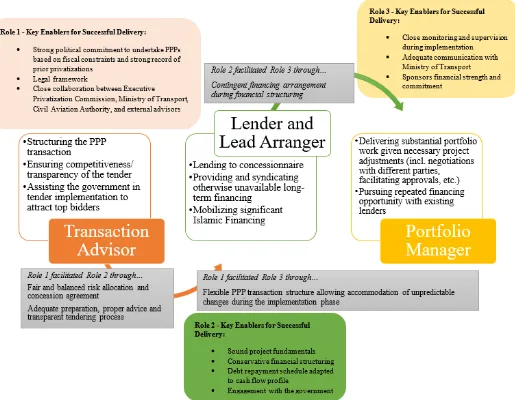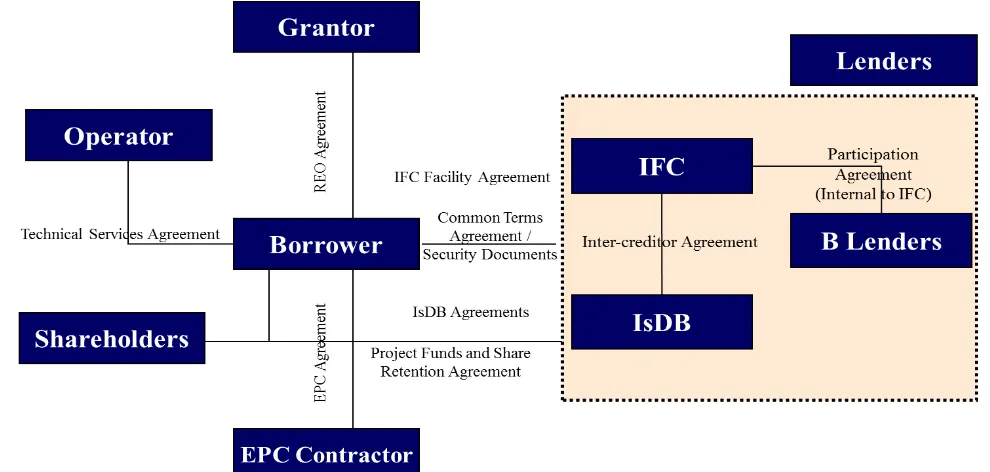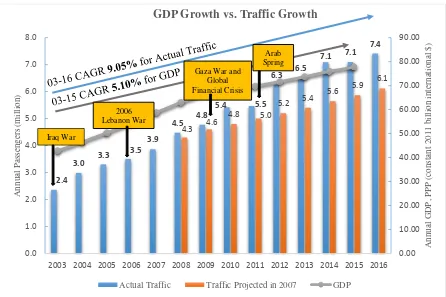www.ifc.org/ThoughtLeadership
Note 35 | April 2017
Jordan’s Queen Alia International Airport, located in Amman, was named best airport of its size in the Middle East by the Airports Council International three years in a row, in 2014, 2015, and 2016, thanks to a 25-year renovation and expansion public-private partnership (PPP) project that was co-financed by IFC and the Islamic Development Bank from 2007 to 2016.
During the process IFC assumed three distinct roles: First as a transaction advisor to the Jordanian government, then as a senior lender and lead arranger of the financing to the concessionaire, and finally as a portfolio manager during the implementation of the project. Figure 1 below expands on these three roles.
Role One: Transaction advisor ensuring reasonable risk allocation and a transparent bidding process (2006-2007)
In the late 1980s Jordan experienced a major economic downturn that drove government debt as high as 174 percent of GDP.
In order to reduce its debt, from 1998 to 2008 the government privatized 14 state-owned enterprises in telecommunications, electricity, air transport, and mining, and other sectors, mostly through technical assistance and financing from the World Bank and the United States Agency for International Development. By 2000, government debt had fallen to 100 percent of GDP, and further to 60 percent of GDP in 2008.
Given the progress made, the government maintained its commitment to privatization by enacting the 2000 Privatization Law, as well as establishing the Executive Privatization Commission, a centralized privatization unit for future transactions.
With advice from the World Bank, the government launched a second generation of privatizations through public-private partnership agreements in mega infrastructure projects. In 2005 the government turned its attention to the Queen Alia
International Airport, which was built in 1983 and accounted for 97 percent of all air traffic in Jordan, with the aim of constructing a new terminal.
Hoping to realize the country’s full potential for tourism and economic development, the government considered private sector participation in order to construct a new terminal with expanded capacity. In preparation for this project the government appointed IFC in February 2006 as lead advisor to analyze private sector participation possibilities.
IFC recommended structuring the project with a 25-year build-operate-transfer contract. Instead of a using negotiated arrangement with an unsolicited proposal, IFC instead assisted the government in conducting the competitive tendering process which involved five bids from consortia of international, regional, and local investors, including the major airport operators.
With the Executive Privatization Commission, the Ministry of Transport, and the Civil Aviation Authority, IFC’s PPP advisory team designed a Rehabilitation, Expansion & Operation Agreement, or concession contract.
In May 2007, the Airport International Group, an international consortium composed of construction group Joannou & Paraskevaides Ltd., airport operator Aéroports de Paris Management S.A., and regional financial investors (Engineering and Development Group Investment Holdings Ltd., Noor Financial Investment Company KSCC, and Abu Dhabi Investment Company), won the bid and signed the Rehabilitation, Expansion & Operation Agreement. As part of its bid the Group offered the government a 54.6 percent share of gross revenue. A critical issue was to determine the size of the new terminal, and the initial plan was to expand capacity from about four million passengers per year 12 million, substantially greater than required at the time
.
Queen Alia International Airport
–
The Role of IFC in
Facilitating Private Investment in a Large Airport Project
2
The government subsequently approved a significant resizing
of the conceptual design in consultation with IFC’s advisory team, which advised on a phased implementation approach. The project was split into two phases, the first yielding a capacity of
nine million passengers per year for the new terminal, to be expanded in a second phase to 12 million passengers per year to accommodate future traffic growth.
Figure 1: IFC’s Multiple Roles to Facilitate the Delivery of the QAIA Rehabilitation and Expansion Project
Source: IFC Project Documents
Role Two: Senior lender and lead arranger securing long-term financing (2007)
Considering the political and commercial risks of the project, international commercial banks were reluctant to participate in the financing without the umbrella of a development finance institution such as IFC. As a result, in the same year IFC was appointed as senior lender and lead arranger, where it arranged long-term financing for the 25-year concession.
IFC’s investment team worked with the Airport International Group to structure a financing plan with long-term maturities adequate for the project and its cash-flow profile. In November 2007, IFC provided $120 million in loans to the Group and
arranged a syndication of $160 million from international commercial banks, or B lenders.
3
In addition to this base financing, contingent financing was agreed to by the Group’s shareholders to cover any cost
overruns or other contingencies, a necessity for unforeseeable changes during the construction of the new terminal.
Figure 2. QAIA project contractual structure
Source: IFC Project Documents
Role Three: Portfolio manager facilitating construction adjustments (2008-2013)
Construction of the new terminal was completed in 2013, two years later than scheduled, due to two significant changes—a design variation and the need for a construction re-staging.
The design variation was requested by the Airport International Group due to space shortages for commercial activities in the new terminal. The construction re-staging addressed construction and operational issues that occurred in the course of the new terminal’s completion.
The Airport International Group proposed to phase the project’s construction into stage one, construction of the new terminal and related piers, and stage two, demolition of the old terminal and extension of the piers with additional contact gates.
These changes required a careful review by the project’s stakeholders and involved a revised cost and financing plan, as well as an update of the traffic and financial projections. The additional funding needed to make these changes was provided by the sponsors and by cash generated from the existing terminal’s operations.
The Airport International Group, its sponsors and lenders, as well as the government, all worked together to review and ultimately approve these changes.
IFC’s portfolio management team played an instrumental role in supporting the approval process by all lenders. The Airport International Group adjusted the original design and successfully completed the new terminal, which opened in March 2013.
From 2008 to 2013, IFC’s portfolio management team developed an extensive relationship with the Airport International Group and the other parties involved through close monitoring and supervision. Building upon this partnership, the Group invited IFC to lead the existing lenders to provide additional capital to finance an expanded version of stage two—designed to enable the airport to continue to meet traffic growth.
In mid-2014 IFC committed $68.8 million in additional senior loans (comprising $21.2 million of own-account financing and $47.6 million in syndicated loans), to finance the expansion of
the new terminal’s related facilities, including a full extension of the piers. This expansion was fully completed in December 2016.
In 2016, 7.4 million passengers traveled through the Queen Alia International Airport, compared to 3.9 million in 2007, when the PPP project was launched. Despite regional turmoil since 2000, passenger traffic grew at a compound annual growth rate of 9.05 percent from 2003 to 2016, equivalent to 1.8 times
Jordan’s GDP growth during the same period.
Jordan’s economic growth and the increase in destinations and frequency of routes served by the Queen Alia International Airport jointly contributed to this significant traffic growth. The two financing rounds of the project resulted in an airport that can handle up to 12 million passengers a year, fulfilling the
Figure 3. GDP growth versus QAIA traffic growth in Jordan, 2003-2016
Source: IFC Project Documents, World Development Indicators, The World Bank, 2016
Conclusion
The successful completion of the Queen Alia International Airport—Jordan’s largest private sector investment project to date—demonstrates the value of private sector capital in infrastructure financing, the complexity of implementation, and the role that multilateral development banks can play in facilitating private investment.
Tremendous effort by the government and financial institutions supported upstream reforms, fair concession design, a competitive tendering process, and a flexible transaction structure, all of which were essential to improving the project’s creditworthiness.
Given the $1.5 trillion infrastructural financing gap (per annum) that developing countries need to fill to meet the Sustainable Development Goals established in 2015, IFC and other development banks are expected to assume multiple roles to help countries effectively use private financing for key infrastructure projects.
Lin Shi, Strategy Analyst, Thought Leadership, Economics and Private Sector Development, IFC ([email protected])
Thomas Rehermann, Senior Economist, Thought Leadership,
Economics and Private Sector Development, IFC ([email protected])
IFC, Jordan: Queen Alia International Airport, Public-Private
Partnership Stories, June 2009.
http://www.ifc.org/wps/wcm/connect/73c497804983917d84cc d6336b93d75f/PPPStories_Jordan_QueenAliaInternationalAir port.pdf?MOD=AJPERES
Website Queen Alia international; Airport, Jordan (QAIA) http://www.qaiairport.com/en
IFC, Jordan: Queen Alia International Airport, Public-Private
Partnership Briefs, May 2015, Publication No 96902.
http://documents.worldbank.org/curated/en/779881467986290 505/pdf/96902-P3Briefs-IFC-26182-JordanQueenAliaAirport-Box391454B-PULBIC-Colltitle-PPP-BRIEF.pdf
World Bank Group, Jordan: Queen Alia Airport, Multilateral
Development Banks’ Collaboration Infrastructure Investment
Project Briefs, April 2016.
http://documents.worldbank.org/curated/en/115491468196146
2003 2004 2005 2006 2007 2008 2009 2010 2011 2012 2013 2014 2015 2016
A
GDP Growth vs. Traffic Growth
Actual Traffic Traffic Projected in 2007 GDP


